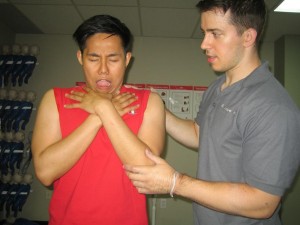Choking is a condition where the airways are blocked by a foreign object, this condition can become life-threatening if the person cannot remove the blockage by simply coughing or clearing their throat. Foodstuffs and small objects can be stuck down your throat which can block air in flowing to your lungs, this prevents your body from supplying oxygen to important systems of your body such as your brain. If the person suffers from choking for a prolonged amount of time, they may suffer from complications such as brain damage or eventually lead to death.
It is important to keep an eye out for someone who is choking as an immediate action will save their life. If you suspect someone is choking, you can ask them if they are choking.
Signs and symptoms of a choking person:
- Having difficulty or inability to talk.
- Loss of consciousness due to the lack of oxygen.

If the person suffers from choking for a prolonged amount of time, they may suffer from complications such as brain damage or eventually lead to death. - Discoloration of the skin to a pale or bluish color.
- Constant coughing that may be weak or forceful.
- Difficulty breathing.
If someone is choking, to deliver first aid to the person, there are various methods for treating choking:
- Give five (5) blows to the back of the person.
- Give five (5) abdominal thrusts to the person.
- Alternate between the two options until the blockage has been removed.
If you are alone, and you are choking, perform abdominal thrusts to yourself:
- Place a fist slightly above your stomach.
- Grasp your fist with another fist and bend over a hard surface.
- Shove your fist to an inward and upward motion until the blockage is removed.
If the victim is unconscious, do the following:
- Lower the person to their back flat on the ground and their arms on the side.
- Clear the airway by reaching a finger into the mouth and attempt to sweep out the blockage if its visible at the back of the mouth.
- Perform CPR onto the person if the blockage hasn’t been removed and the person is unresponsive even after doing the steps above.
Disclaimer / More Information
The material posted on this page on choking is for learning purposes only. Learn to recognize the signs and how it is managed by taking a first aid and CPR class with one of our training providers.
